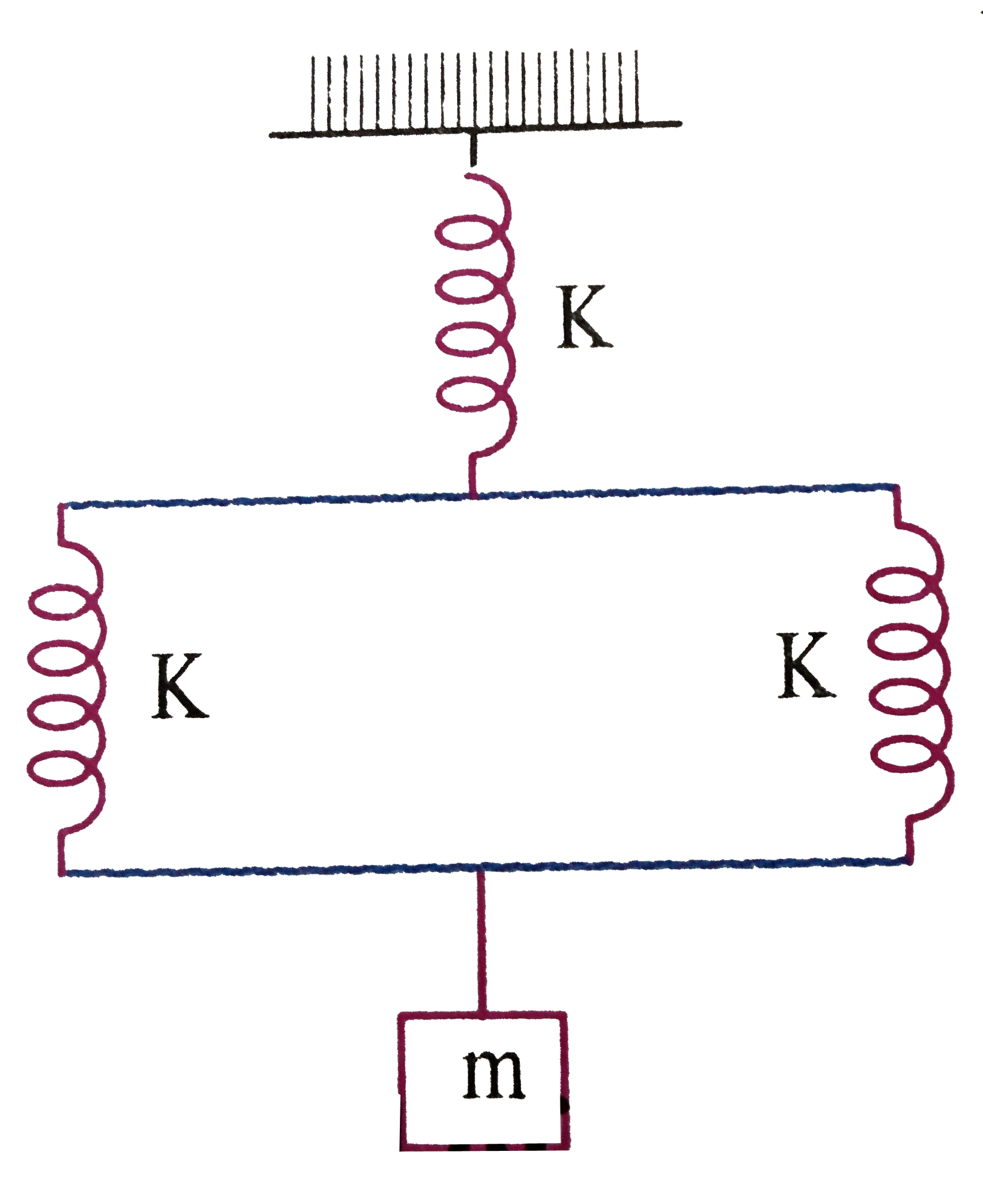When a mass of 1 kg is suspended from a spring, it is stretched by 0.4m. A mass of 0.25 kg is suspended from the spring and the spring is allowed to oscillate. If g=10m/s2, then its period of oscillation will be
0.5 sec
0.4 sec
0.628 sec
1.5 sec
The correct Answer is:C
To solve the problem, we need to find the period of oscillation of a mass-spring system. Here are the steps to arrive at the solution:
Step 1: Understand the problem and gather the given data
- We have a mass M=1kg that stretches the spring by x=0.4m.
- We also have a smaller mass m=0.25kg that will oscillate on the same spring.
- The acceleration due to gravity g=10m/s2.
Step 2: Calculate the spring constant k
The weight of the mass M causes the spring to stretch. The force exerted by the mass is given by:
F=M⋅g=1kg⋅10m/s2=10N
According to Hooke's Law, the force exerted by the spring is:
F=k⋅x
Setting the two expressions for force equal gives:
k⋅x=M⋅g
Substituting the known values:
k⋅0.4=10
Solving for k:
k=100.4=25N/m
Step 3: Use the formula for the period of oscillation
The formula for the period T of a mass-spring system is given by:
T=2π√mk
Where m is the mass that is oscillating (in this case, m=0.25kg) and k is the spring constant we just calculated.
Step 4: Substitute the values into the formula
Substituting m=0.25kg and k=25N/m:
T=2π√0.2525
Calculating the fraction:
0.2525=0.01
Now, taking the square root:
√0.01=0.1
Thus, substituting back into the formula:
T=2π⋅0.1=0.2π
Step 5: Calculate the numerical value
Using π≈3.14:
T≈0.2⋅3.14=0.628s
Final Answer
The period of oscillation is approximately 0.628s.
- We have a mass M=1kg that stretches the spring by x=0.4m.
- We also have a smaller mass m=0.25kg that will oscillate on the same spring.
- The acceleration due to gravity g=10m/s2.
The weight of the mass M causes the spring to stretch. The force exerted by the mass is given by:
F=M⋅g=1kg⋅10m/s2=10N
According to Hooke's Law, the force exerted by the spring is:
F=k⋅x
Setting the two expressions for force equal gives:
k⋅x=M⋅g
Substituting the known values:
k⋅0.4=10
Solving for k:
k=100.4=25N/m
The formula for the period T of a mass-spring system is given by:
T=2π√mk
Where m is the mass that is oscillating (in this case, m=0.25kg) and k is the spring constant we just calculated.
Substituting m=0.25kg and k=25N/m:
T=2π√0.2525
Calculating the fraction:
0.2525=0.01
Now, taking the square root:
√0.01=0.1
Thus, substituting back into the formula:
T=2π⋅0.1=0.2π
Using π≈3.14:
T≈0.2⋅3.14=0.628s
The period of oscillation is approximately 0.628s.
Topper's Solved these Questions
Similar Questions
A block with a mass of 3.00kg is suspended from an ideal spring having negligible mass and stretches the spring by 0.2m.
(a) What is the force constant of the spring?
(b) What is the period of oscillation of the block if it is pulled down and released ?View SolutionA force of 6.4 N stretches a vertical spring by 0.1 m. The mass (in kg) that must be suspended from the spring so that it oscillates with a time period of π4 second.
View Solution
Knowledge Check
- Question 1 - Select One
When a mass M is suspended from a spring, its period of oscillation is 2 second. If a mass 4 M is suspended from the same spring, then its period of oscillation will be
A2 secB1 secC4 secD8 sec - Question 2 - Select One
A body of mass m is suspended from three springs as shown in figure. If mass m is displaced slightly then time period of oscillation is
 A2π√m3KB2π√3m2KC2π√2m3KD2π√3Km
A2π√m3KB2π√3m2KC2π√2m3KD2π√3Km - Question 3 - Select One
A spring is stretched by 0.20 m , when a mass of 0.50 kg is suspended. When a mass of 0.25 kg is suspended, then its period of oscillation will be (g=10m/s2)
A0.328 secB0.628 secC0.137 secD1.00 sec
A 4-kg block extends a spring by 16 cm from its unstretched postion .The block is removed and a 0.5 -kg boby is hung from the same spring If the spring is then stretched and released , what is the time period of oscillations of the mass suspendrd ? What is the force constant of the spring ?
View Solution
The period of oscillation of a mass M suspended from a spring of spring constant K is T. the time period of oscillation of combined blocks isView SolutionA force of 6.4 N stretches a vertical spring by 0.1m. Find the mass that must be suspended from the spring so that it oscillates with a period of π/4
second.View Solution1 kg weight is suspended to a weightless spring and it has time period T. If now 4 kg weight is suspended from the same spring the time period will be
View SolutionA mass of 1 kg is suspended from a spring. Its time period of oscillation on the earth is T. What will be its time periods at the centre of the earth?
View Solution

